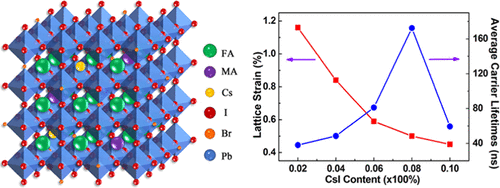当前位置:
X-MOL 学术
›
ACS Appl. Mater. Interfaces
›
论文详情
Our official English website, www.x-mol.net, welcomes your feedback! (Note: you will need to create a separate account there.)
Accurate Adjusting the Lattice Strain of Triple-Cation and Mixed-Halide Perovskites for High-Performance Photodetector
ACS Applied Materials & Interfaces ( IF 9.5 ) Pub Date : 2022-06-10 , DOI: 10.1021/acsami.2c02427 Wenchi Kong 1, 2 , Chen Zhao 1, 2 , Tao Huang 1, 2 , Xiuyun Li 1, 2 , Jun Xing 3 , Zhi Yu 1, 4 , Peng Yang 5 , Wei Li 1 , Weili Yu 1
ACS Applied Materials & Interfaces ( IF 9.5 ) Pub Date : 2022-06-10 , DOI: 10.1021/acsami.2c02427 Wenchi Kong 1, 2 , Chen Zhao 1, 2 , Tao Huang 1, 2 , Xiuyun Li 1, 2 , Jun Xing 3 , Zhi Yu 1, 4 , Peng Yang 5 , Wei Li 1 , Weili Yu 1
Affiliation

|
The instability of perovskite optoelectronic devices remains a big barrier to their commercialization. The instability caused by external stimuli has been addressed by encapsulation, such as humidity, oxygen, heat, and ultraviolet light. However, the intrinsic instability of perovskite materials due to the lattice strain has not been fully addressed, which affects the physical properties and device performance to a great extent. Tuning the lattice strain by controlling the perovskite composition and ratio is an effective way to further develop efficient and stable devices. Herein, we prepare a series of triple-cation and mixed-halide (FAPbI3)x(MAPbBr3)y(CsPbI3)1–x−y perovskite single-crystal thin films and study the effect of lattice strain on the perovskite optoelectronic properties. Especially, the perovskite photodetector with a horizontal structure based on (FAPbI3)0.79(MAPbBr3)0.13(CsPbI3)0.08 single-crystal thin films exhibits excellent performance with an enhanced responsivity of 40 A/W, high detectivity of 1.9 × 1013 Jones, external quantum efficiency of 9100%, and superior stability. This can be explained by the fact that the optimal coordination between each element leads to the release of lattice strain and further produces low defect density and long carrier lifetime in (FAPbI3)0.79(MAPbBr3)0.13(CsPbI3)0.08 single-crystal thin films. This research shows the significance of ion ratios in tuning lattice strain and determining the intrinsic device performance and makes the perovskite (FAPbI3)0.79(MAPbBr3)0.13(CsPbI3)0.08 a promising candidate for the next generation of optoelectronic devices.
中文翻译:

精确调整三阳离子和混合卤化物钙钛矿的晶格应变用于高性能光电探测器
钙钛矿光电器件的不稳定性仍然是其商业化的一大障碍。由外部刺激引起的不稳定性已通过封装解决,例如湿度、氧气、热量和紫外线。然而,由于晶格应变引起的钙钛矿材料固有的不稳定性尚未得到充分解决,这在很大程度上影响了物理性能和器件性能。通过控制钙钛矿成分和比例来调整晶格应变是进一步开发高效稳定器件的有效途径。在此,我们制备了一系列三阳离子和混合卤化物 (FAPbI 3 ) x (MAPbBr 3 ) y (CsPbI 3 ) 1– x -y钙钛矿单晶薄膜并研究晶格应变对钙钛矿光电性能的影响。特别是基于(FAPbI 3 ) 0.79 (MAPbBr 3 ) 0.13 (CsPbI 3 ) 0.08单晶薄膜的水平结构钙钛矿光电探测器表现出优异的性能,响应度提高了40 A/W,探测率达到1.9 × 10 13 Jones,外量子效率9100%,稳定性超强。这可以通过以下事实来解释:每个元素之间的最佳配位导致晶格应变的释放,并进一步产生低缺陷密度和长载流子寿命(FAPbI 3) 0.79 (MAPbBr 3 ) 0.13 (CsPbI 3 ) 0.08单晶薄膜。该研究表明离子比率在调节晶格应变和确定器件固有性能方面的重要性,并使钙钛矿 (FAPbI 3 ) 0.79 (MAPbBr 3 ) 0.13 (CsPbI 3 ) 0.08成为下一代光电器件的有希望的候选者。
更新日期:2022-06-10
中文翻译:

精确调整三阳离子和混合卤化物钙钛矿的晶格应变用于高性能光电探测器
钙钛矿光电器件的不稳定性仍然是其商业化的一大障碍。由外部刺激引起的不稳定性已通过封装解决,例如湿度、氧气、热量和紫外线。然而,由于晶格应变引起的钙钛矿材料固有的不稳定性尚未得到充分解决,这在很大程度上影响了物理性能和器件性能。通过控制钙钛矿成分和比例来调整晶格应变是进一步开发高效稳定器件的有效途径。在此,我们制备了一系列三阳离子和混合卤化物 (FAPbI 3 ) x (MAPbBr 3 ) y (CsPbI 3 ) 1– x -y钙钛矿单晶薄膜并研究晶格应变对钙钛矿光电性能的影响。特别是基于(FAPbI 3 ) 0.79 (MAPbBr 3 ) 0.13 (CsPbI 3 ) 0.08单晶薄膜的水平结构钙钛矿光电探测器表现出优异的性能,响应度提高了40 A/W,探测率达到1.9 × 10 13 Jones,外量子效率9100%,稳定性超强。这可以通过以下事实来解释:每个元素之间的最佳配位导致晶格应变的释放,并进一步产生低缺陷密度和长载流子寿命(FAPbI 3) 0.79 (MAPbBr 3 ) 0.13 (CsPbI 3 ) 0.08单晶薄膜。该研究表明离子比率在调节晶格应变和确定器件固有性能方面的重要性,并使钙钛矿 (FAPbI 3 ) 0.79 (MAPbBr 3 ) 0.13 (CsPbI 3 ) 0.08成为下一代光电器件的有希望的候选者。


























 京公网安备 11010802027423号
京公网安备 11010802027423号